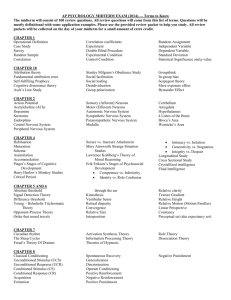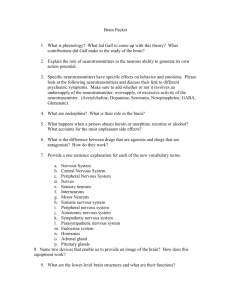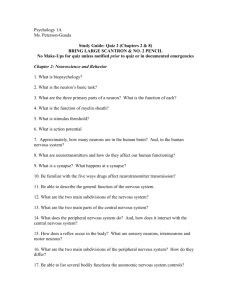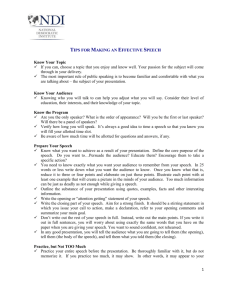BIO 100 Study Guide Assignment #24 Chapter 13 COORDINATION
advertisement
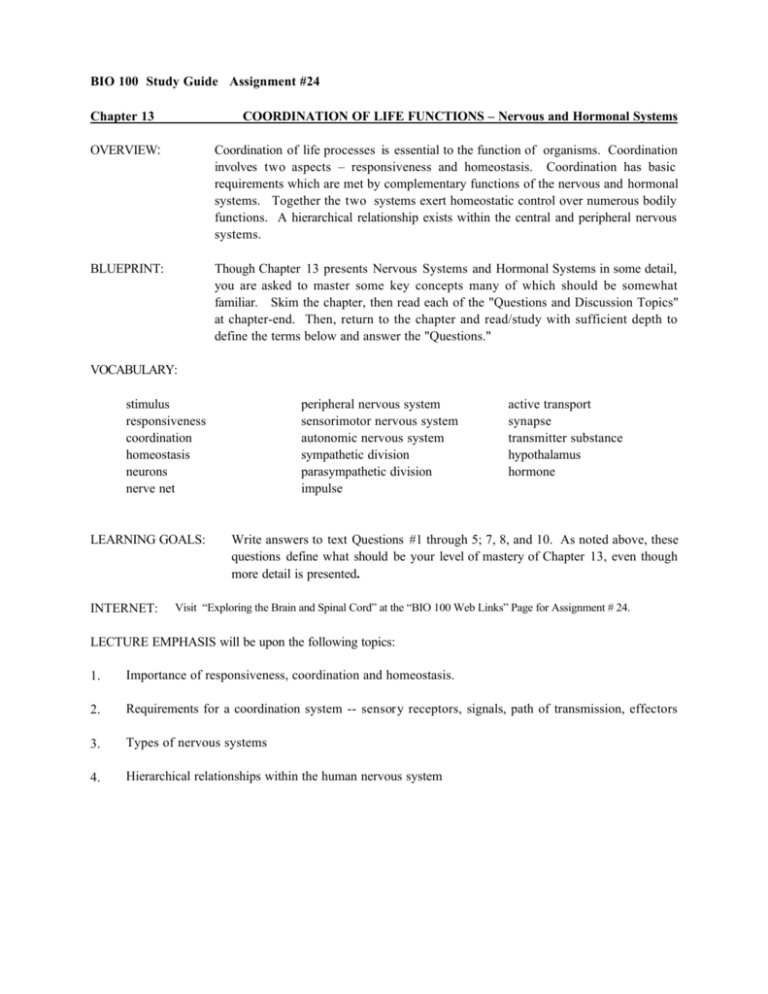
BIO 100 Study Guide Assignment #24 Chapter 13 COORDINATION OF LIFE FUNCTIONS – Nervous and Hormonal Systems OVERVIEW: Coordination of life processes is essential to the function of organisms. Coordination involves two aspects – responsiveness and homeostasis. Coordination has basic requirements which are met by complementary functions of the nervous and hormonal systems. Together the two systems exert homeostatic control over numerous bodily functions. A hierarchical relationship exists within the central and peripheral nervous systems. BLUEPRINT: Though Chapter 13 presents Nervous Systems and Hormonal Systems in some detail, you are asked to master some key concepts many of which should be somewhat familiar. Skim the chapter, then read each of the "Questions and Discussion Topics" at chapter-end. Then, return to the chapter and read/study with sufficient depth to define the terms below and answer the "Questions." VOCABULARY: stimulus responsiveness coordination homeostasis neurons nerve net LEARNING GOALS: INTERNET: peripheral nervous system sensorimotor nervous system autonomic nervous system sympathetic division parasympathetic division impulse active transport synapse transmitter substance hypothalamus hormone Write answers to text Questions #1 through 5; 7, 8, and 10. As noted above, these questions define what should be your level of mastery of Chapter 13, even though more detail is presented. Visit “Exploring the Brain and Spinal Cord” at the “BIO 100 Web Links” Page for Assignment # 24. LECTURE EMPHASIS will be upon the following topics: 1. Importance of responsiveness, coordination and homeostasis. 2. Requirements for a coordination system -- sensory receptors, signals, path of transmission, effectors 3. Types of nervous systems 4. Hierarchical relationships within the human nervous system STUDY OUTLINE: COORDINATION SYSTEMS --- NERVOUS I. OVERVIEW: reproduction COORDINATION is the third of the basic life process after nutrition and II. DEFINITION: Control of individual processes (i.e. nutrition, reproduction, movement) to produce a harmonious whole. III. TWO ASPECTS OF COORDINATION: A. Responsiveness – to (e.g._________________) stimuli, both external AND HORMONAL SYSTEMS (environmental) and B. Homeostasis – maintenance of steady state in the midst of environmental changes IV REQUIREMENTS: A. Sensory Receptors – B. Transmission of Signals via 1. _________________________________________________________________ 2. _________________________________________________________________ C. Effectors – to bring about responses 1. _________________________________________________________________ 2. _________________________________________________________________ D. Information Processing – by Central Nervous System V. NEURONS AND IMPULSE TRANSMISSION A. Three types of NEURONS: 1. Sensory neurons – 2. Motor neurons – 3. Interneurons – B. Impulses – 1. Depolarization 2. Direction C. Synapse – internal VI. ORGANIZATION OF NERVOUS SYSTEMS A. Trends among Hydra, Planaria, and Earthworm: ________________________________ B. Human Nervous System 1. Structural Subdivisions: a. Central Nervous System – b. Peripheral Nervous System – 2. Functional Subdivisions: a. Sensorimotor – b. Autonomic – i. Sympathetic – ii. Paraympathetic VII. APPLICATIONS: Chapter 13 and 14 discuss numerous homeostatic processes that require the function of the autonomic nervous system and endocrine glands, including: A. Body Temperature Regulation – via shivering, sweating, etc. to balance heat gain/loss B. Blood Oxygen Levels – via heart and breathing rates [Laboratory Exercise] C. Blood waste and water levels – via kidneys [Included only if time permits] D. Blood Glucose Levels – to be discussed E. Female Reproductive (Menstrual) Cycle – to be discussed


